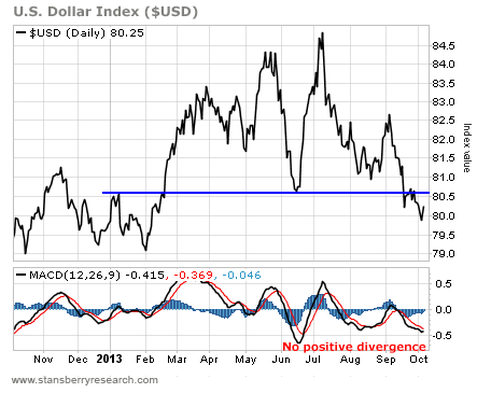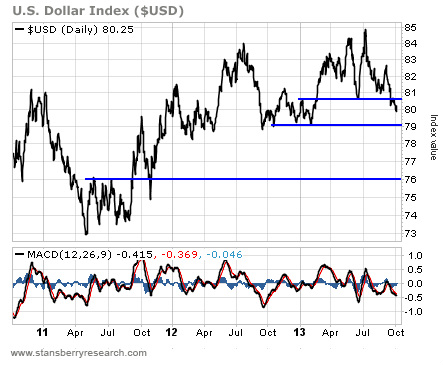| RETIRE RICH Many middle-class Americans apparently aren't expecting to live their golden years in leisurely retirement. A hefty 34 percent of them think they will work until at least the age of 80 because they haven't saved enough for retirement, according to a Wells Fargo study survey conducted by Harris Interactive. That's up from 25 percent in 2011 and 30 percent in 2012. |
Opinion: Retirees to Be Hit With Social Security Cuts
37 percent say they'll never retire and will work until they are too sick or die. What's the solution to this?
Building savings and creating a retirement plan can improve the retirements for those now in their working years, says Laurie Nordquist, head of Wells Fargo Institutional Retirement and Trust
Meanwhile, a 59 percent majority of the middle class say paying monthly bills is their chief day-to-day financial concern. That's up from 52 percent last year. Saving for retirement takes second place, with 13 percent calling it a priority. Overall, 42 percent say saving for retirement and paying bills concurrently is impossible.
Thus 48 percent don't have confidence that they will be able to save enough for a comfortable retirement.
The survey of 1,000 middle-class Americans between the ages of 25 and 75 was conducted July 24 to Aug. 27. "For the past three years, the struggle to pay bills is a growing concern, and the prospect of saving for retirement looks dim, particularly for those in their prime saving years," Nordquist says in a statement.
"Having a plan and saving not only creates more hopefulness, but it produces results that can grow and lead to a solid retirement."
In the survey, 52 percent of the middle class say they are confident they will save enough for retirement. But only 29 percent say they have a written plan. Among those who have a written plan, 70 percent feel confident about their retirement, while only 44 percent of those who don't have a plan feel confident. Of those who have a plan, 91 percent say they have willpower to save, compared with 75 percent for those who don't have a plan.
In the key 40-to-59 demographic, those who say they have written a plan also say they have saved $63,000 for retirement, while those who say they haven't written a plan say they have saved $20,000. "This data so clearly shows what a difference a retirement plan makes in that people who have a plan have saved three times what those without a plan have saved," Nordquist explains. "A plan instills confidence and gives people the discipline to stick with their objectives and reach their financial goals."
As for the respondents who don't have a written retirement plan, 45 percent say it's because they have "so few financial assets." One-third of the middle class say Social Security will be their "primary" source of income in retirement.
"People say they don't have a plan because they don't have enough money," Nordquist notes. "The most important message I can impart about retirement is that planning is for everyone. It is the foundation for consistent savings, which can allow people to have the nest egg they will need in retirement and can also help people determine the role Social Security will play in their retirement."
Further, 40 percent say a large unexpected healthcare expense represents their biggest retirement fear, while and 37 percent list the loss or reduction of Social Security as fear No. 1. As for the stock market, only 24 percent of the middle class view stocks as a good investment for retirement. Meanwhile, 45 percent say "the stock market doesn't benefit people like me."
A majority (52 percent) say they shun stocks because "I am afraid to lose my nest egg in the ups and downs of the market." Surprisingly enough, fear of the stock market is more intense among those aged 25 to 29, with 56 percent of them afraid they would lose their savings in equities. Asked what they would do with $5,000 given to them for retirement investment, 58 percent of people in this age group say they would allocate it to a saving account or certificate of deposit.
The reluctance for stocks may stem partly from the fact that 51 percent of the middle class say they have little interest in learning about investing. Nordquist is struck by the fear of stocks. "The middle class just isn't making the link between being invested and the potential growth of their savings, but on top of this fear is apathy. There is no interest in learning more about investing," she states. "Fear and apathy are a bad combination, whereas knowledge about saving and investing is empowering. We've got to move people to this mindset."
37 percent say they'll never retire and will work until they are too sick or die. What's the solution to this?
Building savings and creating a retirement plan can improve the retirements for those now in their working years, says Laurie Nordquist, head of Wells Fargo Institutional Retirement and Trust
Meanwhile, a 59 percent majority of the middle class say paying monthly bills is their chief day-to-day financial concern. That's up from 52 percent last year. Saving for retirement takes second place, with 13 percent calling it a priority. Overall, 42 percent say saving for retirement and paying bills concurrently is impossible.
Thus 48 percent don't have confidence that they will be able to save enough for a comfortable retirement.
The survey of 1,000 middle-class Americans between the ages of 25 and 75 was conducted July 24 to Aug. 27. "For the past three years, the struggle to pay bills is a growing concern, and the prospect of saving for retirement looks dim, particularly for those in their prime saving years," Nordquist says in a statement.
"Having a plan and saving not only creates more hopefulness, but it produces results that can grow and lead to a solid retirement."
In the survey, 52 percent of the middle class say they are confident they will save enough for retirement. But only 29 percent say they have a written plan. Among those who have a written plan, 70 percent feel confident about their retirement, while only 44 percent of those who don't have a plan feel confident. Of those who have a plan, 91 percent say they have willpower to save, compared with 75 percent for those who don't have a plan.
In the key 40-to-59 demographic, those who say they have written a plan also say they have saved $63,000 for retirement, while those who say they haven't written a plan say they have saved $20,000. "This data so clearly shows what a difference a retirement plan makes in that people who have a plan have saved three times what those without a plan have saved," Nordquist explains. "A plan instills confidence and gives people the discipline to stick with their objectives and reach their financial goals."
As for the respondents who don't have a written retirement plan, 45 percent say it's because they have "so few financial assets." One-third of the middle class say Social Security will be their "primary" source of income in retirement.
"People say they don't have a plan because they don't have enough money," Nordquist notes. "The most important message I can impart about retirement is that planning is for everyone. It is the foundation for consistent savings, which can allow people to have the nest egg they will need in retirement and can also help people determine the role Social Security will play in their retirement."
Further, 40 percent say a large unexpected healthcare expense represents their biggest retirement fear, while and 37 percent list the loss or reduction of Social Security as fear No. 1. As for the stock market, only 24 percent of the middle class view stocks as a good investment for retirement. Meanwhile, 45 percent say "the stock market doesn't benefit people like me."
A majority (52 percent) say they shun stocks because "I am afraid to lose my nest egg in the ups and downs of the market." Surprisingly enough, fear of the stock market is more intense among those aged 25 to 29, with 56 percent of them afraid they would lose their savings in equities. Asked what they would do with $5,000 given to them for retirement investment, 58 percent of people in this age group say they would allocate it to a saving account or certificate of deposit.
The reluctance for stocks may stem partly from the fact that 51 percent of the middle class say they have little interest in learning about investing. Nordquist is struck by the fear of stocks. "The middle class just isn't making the link between being invested and the potential growth of their savings, but on top of this fear is apathy. There is no interest in learning more about investing," she states. "Fear and apathy are a bad combination, whereas knowledge about saving and investing is empowering. We've got to move people to this mindset."





 RSS Feed
RSS Feed
